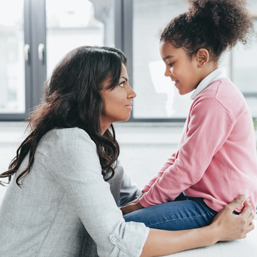
Most of us have had the frustrating experience of asking our children questions and receiving one-word answers: “What did you do at school today?” The answer: “Nothing.” You want to engage your kids in conversation that lets you know what they’re thinking, how they’re feeling, and whether or not they need support of some kind. So, it’s difficult when you hit one-word dead ends.
But there is hope. You can teach your children to engage in conversation and open up to you by asking them open-ended questions. And the younger a child is when you begin to do this, the better.
Why open-ended questions?
Big, open-ended questions that can have a thousand answers support a child’s language development as well as critical-thinking skills. You don’t want to ask your child, “Did you have fun today?” which will elicit a yes or no answer. Instead say, “How was your day? Tell me about it.”
When children respond to open-ended questions, they gain confidence in their ability to interact with others. They learn to analyze and evaluate what they’ve done and the things they’ve learned. They’re encouraged to respond with creativity and reflection. Even a shy child will begin to open up when asked a question that gets to the heart of their emotions.
How to ask the right question
When your purpose in asking a question is to encourage a conversation, you’ll want to ask at an appropriate time. Often, the best time to ask questions is when a child is engaged in a project of some sort. While you may not want to interrupt their thinking, they are more likely to be open to sharing their thought processes when they’re actively engaged.
If your purpose in asking a question is to problem-solve, you’ll want to avoid, “Why did you…?” Instead, preface your question with, “How could you fix it?” or “What are your options now?” This puts the responsibility for coming to a solution on your child and you can guide their thinking to a satisfactory conclusion.
Again, don’t ask a yes or no question unless you follow up with, “Tell me more.”
Here are some question starters that may work for you; some are statements geared to thoughtful answers:
Three ways to encourage full answers
1. When you ask an open-ended question, allow enough wait time for your child to process the question and formulate an answer.
2. Use active-listening skills: make eye contact, restate their words to help them solidify and extend answers. “I heard you say…” “Did you mean…?” “Are you saying…?”
3. Use follow-up responses such as, “Tell me more about…” and “What else…?”
When you take the time to engage in meaningful conversations with your children, you are building valuable rapport and trust with them. Rather than feeling bombarded by invasive questions they don’t want to answer, they’ve been taught all along to share their thoughts, emotions, their ‘wonderings.’
This invitation to communicate will benefit your children in many ways; they’ll learn how to gather information, understand how they come to conclusions, extend their vocabulary and their logical-thinking skills, know their thoughts are appreciated, and gain valuable practice in communication skills that will aid in their learning throughout life.
Jan Pierce, M.Ed., is a retired teacher and writer. She is the author of Homegrown Readers and Homegrown Family Fun. Find her at janpierce.net.
Calgary’s Child Magazine © 2024 Calgary’s Child